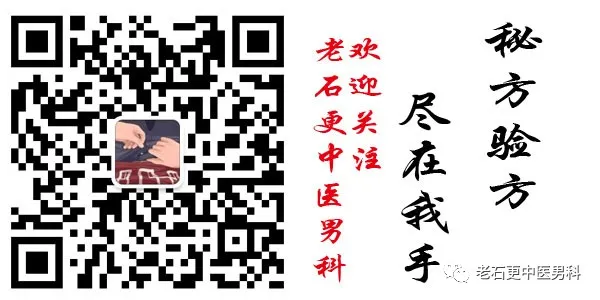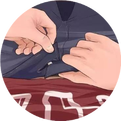Premature ejaculation (早-泄, zǎo-xiè, PE) is a common sexual dysfunction in adult males, with an incidence rate of approximately 20% to 30% among men aged 18 to 65. This condition can lead to dissatisfaction in both partners, with men feeling pressured and women left unfulfilled. Modern research indicates that PE can cause a loss of confidence in men, often accompanied by anxiety, distress, frustration, or avoidance of sexual activity, creating a vicious psychological cycle that can affect marital harmony. Given the complex etiology and pathogenesis of PE, treatment methods vary widely, with inconsistent efficacy. Currently, pharmacological treatment remains the first-line therapy, primarily involving selective serotonin reuptake inhibitors. However, topical medications also play a significant role, with clinical practice often utilizing local applications on the glans penis, primarily using topical anesthetics, which can diminish overall sexual pleasure. Traditional Chinese medicine (TCM) has employed external treatments for PE for a long time, and clinical practice has confirmed their effectiveness and safety.
Our hospital has achieved certain therapeutic effects using TCM external ointments, which not only facilitate full erection and prolong ejaculation time but also enhance the sexual experience for men, addressing the shortcomings of existing treatment methods and opening new avenues for therapy. The following report details our findings.
1 General Information
From October 2015 to February 2017, patients diagnosed with PE at our hospital were randomly divided into a treatment group (51 cases) and a control group (45 cases). In the treatment group, the youngest patient was 22 years old, the oldest was 50 years old, with an average age of (32.35±7.78) years; in the control group, the youngest was 23 years old, the oldest was 50 years old, with an average age of (33.56±8.43) years. There were no statistically significant differences in age or duration of illness between the two groups (P > 0.05), indicating comparability.
2 Diagnostic Criteria
2.1 TCM Diagnostic Criteria
The traditional TCM definition of PE is “ejaculation before or immediately upon penetration.” Modern definitions refer to the “Guidelines for Clinical Research on New Chinese Medicines,” which state that PE is diagnosed when ejaculation occurs before or shortly after penetration, specifically within one minute, and this condition persists for at least one month.
2.2 Western Medical Diagnostic Criteria
International medical societies define PE as ejaculation occurring before or shortly after penetration, typically within one minute, with an inability to control ejaculation, accompanied by feelings of distress, pain, frustration, and/or avoidance of intimate contact.
3 Inclusion Criteria
① All cases met the TCM diagnostic criteria for PE; ② Age between 22 and 50 years; ③ Patients had not received any related TCM or Western medicine treatment within one month prior to inclusion.
4 Exclusion Criteria
① Moderate to severe erectile dysfunction; ② History of severe diabetes, hypertension, heart disease, or lumbar disc disease; ③ Pseudopremature ejaculation; ④ Prostatitis; ⑤ Phimosis; ⑥ Marital tension due to non-PE causes.
5 Treatment Group
Composition of the Ointment:15g of Cinnamon (肉桂, ròu guì), 30g of Cnidium (蛇床子, shé chuáng zǐ), 15g of Epimedium (淫羊藿, yín yáng huò), 45g of Raw Oyster (生牡蛎, shēng mǔ lì), 6g of Asarum (细辛, xì xīn), 6g of Clove (丁香, dīng xiāng), 20g of Galla Chinensis (五倍子, wǔ bèi zǐ), 15g of Sichuan Pepper (花椒, huā jiāo), 10g of Poria (茯苓, fú líng), 12g of Chinese Yam (山药, shān yào), and 10g of Rehmannia (熟地, shú dì). The above 14 doses are combined with 300g of Ejiao (阿胶, ā jiāo) to prepare an external ointment of 25g to 28g per packet.
6 Control Group
Lidocaine gel. Both groups applied the medication to the glans, frenulum, and coronal sulcus once every evening, allowing it to air dry, and washed it off half an hour before sexual activity. Both groups were instructed to maintain normal sexual activity at least five times a month. Each group underwent a treatment course of four weeks, after which follow-up assessments were conducted to determine efficacy.
7 Precautions
① Prior to use, apply to the skin of the hands to check for allergic reactions before applying to the glans; ② No use of condoms or other oral medications during treatment; ③ Dietary restrictions during treatment: Avoid foods such as leeks, lamb, dog meat, Chinese yam, goji berries, chestnuts, soft-shelled turtle, pig kidneys, black beans, pigeon eggs, oysters, walnuts, black sesame, fox nuts, sea cucumbers, sparrows, walnuts, shrimp, loach, and yellow eels; ④ Avoid alcohol and spicy foods.
8 Observation Items
Assess TCM efficacy and the Premature Ejaculation Profile (PEP) score before treatment and after four weeks of treatment.
9 Efficacy Criteria
Based on the “Guidelines for Clinical Research on New Chinese Medicines”: Recent cure: Successful intercourse within one month post-treatment; Significant effect: Successful intercourse in over 75% of attempts, with ejaculation occurring after more than one minute; Effective: Penetration is possible, with ejaculation occurring in some cases after more than one minute; Ineffective: No change in symptoms before and after treatment.
10 Premature Ejaculation Profile (PEP)
Patients completed the PEP questionnaire before treatment and at the fourth week of treatment, assessing ejaculation control, sexual satisfaction, distress related to PE, and communication difficulties with partners (scoring from 0 to 4, with higher scores indicating greater improvement).
11 Statistical Methods
Data were analyzed using SPSS 20.0 software, with continuous data assessed using t-tests and categorical data using chi-square tests.
12 Treatment Results
Comparison of PEP Scores and TCM Efficacy Between Groups
After four weeks of treatment, there was a significant difference in PEP scores between the two groups compared to before treatment (P < 0.01). The treatment group showed more significant improvement than the control group.
Table 1 Comparison of PEP Scores Between Groups

Comparison of Clinical Efficacy Between Groups
The total effective rate in the treatment group was 78.43%, while in the control group it was 57.78%, indicating that the treatment group outperformed the control group (P < 0.05).See Table 2.
Table 2 Comparison of Clinical Efficacy Between Groups (%)

13 Typical Cases
Jin ×, male, 44 years old, experienced progressively faster ejaculation over 2 years, barely controlling it to around 1 minute, with significant fatigue after intercourse, low confidence, and pessimism. His tongue was red with a thin yellow coating, and his pulse was thin. He had no history of hypertension, diabetes, or coronary heart disease. He occasionally drank small amounts of beer, and physical examination showed no phimosis.He used the “Hua Yue-A” external ointment, applying it evenly to the glans, frenulum, and coronal sulcus every evening, allowing it to air dry, and washing it off half an hour before sexual activity. He maintained normal sexual activity at least five times a month. After one month, he returned for a follow-up, and his ejaculation time had significantly increased to 5 to 7 minutes, with improvements in erection response and hardness. After three months, a follow-up call indicated that his ejaculation time remained stable at the same level, sometimes even reaching 8 to 10 minutes, with noticeable improvements in mental state and physical strength.
14 Discussion
The characteristics of PE include a short ejaculation latency time, poor ejaculation control, and negative emotional outcomes. A lack of sexual skills can also lead to the occurrence of PE. Modern medical research generally recognizes that different individuals have different causes for this condition. Yao Zhimin et al. reported that the primary cause of primary PE is heightened sensitivity of the sensory nerves in the glans compared to normal individuals, which is also related to inflammatory stimulation, phimosis, and neurological disorders. It is a multifactorial result influenced by psychological factors, personality traits, environment, endocrine, and neurobiological factors. Corresponding treatments include psychological therapy, behavioral therapy, partial resection of the dorsal nerve of the penis, oral antidepressants, and topical medications, including local anesthetics.
Topical medications primarily involve the application of anesthetic agents in spray or ointment form to the local epidermis, allowing absorption through the skin to exert their effects. The medication is applied to the glans before intercourse to reduce nerve sensitivity, prolonging the ejaculation latency time within the vagina, thereby achieving the goal of treating PE. In 1943, Schapiro first introduced the use of anesthetic ointments for the treatment of PE. Currently, the most commonly used in clinical practice is a compound lidocaine ointment. W Busato et al. conducted a clinical double-blind randomized controlled trial on 42 men treated with lidocaine-procaine ointment for PE, showing that the treatment group had significantly longer ejaculation latency times than the control group. Gittleman MC reported using a mixed ointment containing 0.5% Dyclonine and 0.4% Alprostadil in 30 PE patients, demonstrating that the synergistic effect was superior to the individual effects, with 17.5% of patients experiencing mild to moderate local adverse reactions. A cream known as SS-cream, containing extracts from nine Chinese herbs, was produced in Korea for the treatment of PE, primarily containing anesthetic substances and vasoactive components. A phase III clinical randomized controlled double-blind study involving 106 patients showed that SS-cream significantly increased ejaculation latency time compared to the placebo group, with treatment group sexual satisfaction rising to 82%, while the placebo group was only 20%, with 18.5% of patients experiencing local irritation after use. Clinically, various topical anesthetics have shown certain therapeutic effects with minimal systemic side effects; however, topical methods can also have adverse effects, such as localized redness and itching resembling allergic reactions, and excessive use can lead to numbness of the penis, affecting normal erection. No medication is perfect, and continuous exploration and updates are needed to improve drug composition and formulations.
China has a profound TCM culture and a rich variety of Chinese herbs. TCM believes that the occurrence of PE is often due to the kidneys failing to secure essence, leading to an inability to contain, and the liver’s dysfunction in regulating, resulting in weakness. The interplay of yin and yang, with wind and fire being excessive, leads to kidney deficiency where water cannot control fire, resulting in the loss of essence and PE. The mechanism of using topical medications to treat PE lies in nourishing the kidneys, thus protecting the kidneys from being invaded by external pathogens, thereby achieving the goal of preventing essence loss. Historical texts from the Mawangdui Han tomb record the use of washes to improve sexual life for health, and subsequent dynasties have documented the use of ointments or powders on the glans to enhance sexual function.
In my clinical practice, I have innovatively refined the ointment using Ejiao as a medium for external application to the glans for treating PE. The formula includes Galla Chinensis to astringe and secure essence, providing a numbing sensation to prolong sexual activity; Cnidium warms the kidneys, assists yang, dispels wind and dampness, preventing the invasion of external pathogens during sexual activity; Asarum contains volatile oils with anesthetic effects, blocking nerve impulse conduction to delay the ejaculation reflex; Asarum also contains dehydroevodiamine, which has antispasmodic and anti-allergic effects, reducing local side effects; it can also dilate blood vessels and improve erection; Epimedium and Cinnamon significantly tonify kidney yang, increasing blood flow to the glans, ensuring it is fully engorged and firm; Clove is warm and fragrant, tonifying the kidneys and assisting yang, while Cinnamon and Sichuan Pepper also warm and assist yang, promoting blood circulation; Raw Oyster revitalizes the skin, astringing and increasing the resilience and endurance of the glans; Chinese Yam, Rehmannia, and Poria tonify the kidneys and stabilize the ointment. The combination of these herbs achieves the effects of dispelling wind, warming the kidneys, securing essence, and enhancing yang.
This clinical trial indicates that the use of our hospital’s “Hua Yue-A” external ointment for treating PE in patients with erectile dysfunction shows significant efficacy compared to lidocaine gel, with noticeable advantages observed by the fourth week of treatment. The PEP scores indicate that this formula not only enhances ejaculation control and effectively prolongs ejaculation time but also improves the sexual satisfaction of both partners, while also regulating and alleviating negative emotions such as frustration and avoidance, thereby restoring the patient’s confidence and improving their quality of life.
Appreciation


